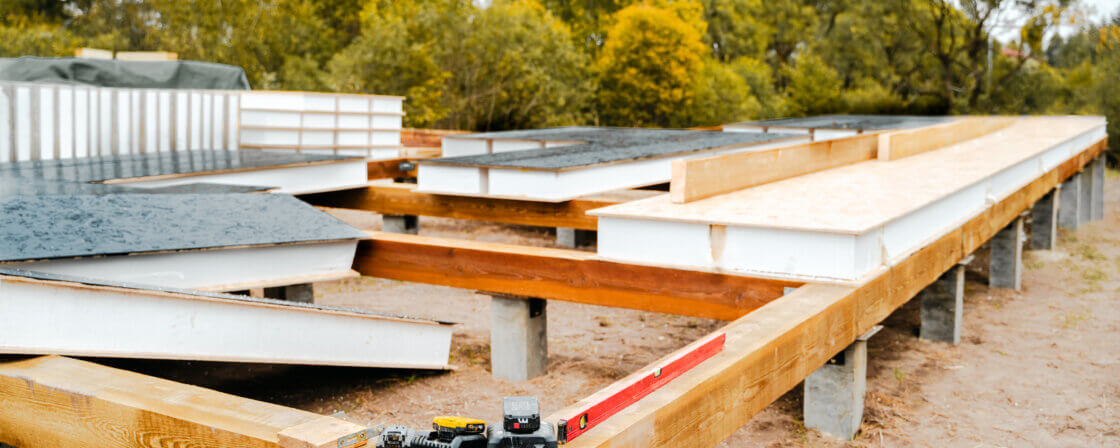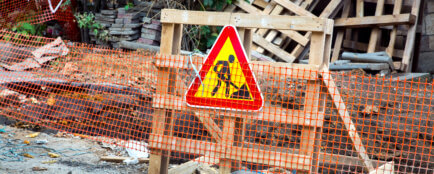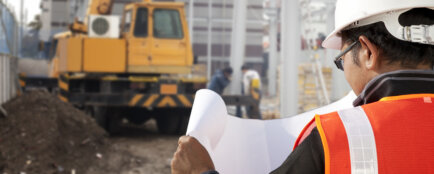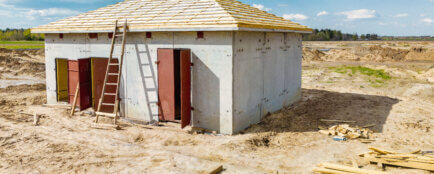What is a temporary structure and what is the definition under the law?
A temporary structure is intended for temporary use, which means that it must not be permanently located. Therefore, it must be clear at the time of permitting that it will not stand permanently. After a set period of time, it must either be removed or converted into a permanent structure (if the law allows it). The building authority may authorise a temporary structure for a maximum of 3 years, unless the law provides otherwise. Upon request of the owner, the time limit may be extended if the zoning plan allows it.
The law does not explicitly mention temporary construction as a separate category, but its temporary nature is implied by the conditions of the permit or notification. In practice, this includes, for example, building cells on construction sites, seasonal stands, temporary warehouses or stands for sporting events. Importantly, even a temporary structure may require a permit if it does not meet the conditions for a vacant site.
In this context, it is worth mentioning that the new legislation has also strengthened the supervision of black structures – if a temporary structure is built without a permit, it risks being removed at the owner’s expense. It is therefore important to check what formalities need to be fulfilled before construction so that legal problems do not arise later.
Are you solving a similar problem?
Solutions Tailored for You
Our team of experienced attorneys will help you solve any legal issue. Within 24 hours we’ll evaluate your situation and suggest a step-by-step solution, including all costs. The price for this proposal is only CZK 690, and this is refunded to you when you order service from us.
I Need help
- When you order, you know what you will get and how much it will cost.
- We handle everything online or in person at one of our 6 offices.
- We handle 8 out of 10 requests within 2 working days.
- We have specialists for every field of law.
When can a temporary building be erected without a permit?
The new Building Act (Act No. 283/2021 Coll.) allows a temporary building to be constructed without a complex approval process in certain cases. For example,buildings up to 40 m² and up to 5 m high can be erected without a permit if they are used for recreation or storage and are not located in a conservation area.
Although permission may not be required, the building must comply with the conditions of the zoning and must not interfere with neighbouring rights. In some cases, the building official may require a notice of the location of the structure.
If you are unsure whether your building needs a permit, consultation with your local building authority is recommended. This will prevent the risk of the authority ordering you to remove the building.
Tip for article
Build a shed, garage or a house on your own land without official permission? It may sound tempting, but the reality is much harsher. The new building law has tightened the rules and black buildings will no longer be treated with kid gloves. What does this mean in practice?
Typical examples of temporary structures
Temporary structures come in many forms, and the new Building Act regulates their use according to their purpose and location. The most common types of temporary structures include:
- Seasonal stalls and kiosks – Typically used at markets or festivals. They can often be placed without a permit as long as they meet the conditions of a free location.
- Mobile homes and modular buildings – These structures may be used for recreational or temporary residential purposes. Although not permanently attached to the ground, they often require a permit, especially if connected to utilities.
- Construction Cells and Temporary Facilities – These are placed on construction sites as offices, warehouses, or locker rooms for workers. They must be removed when construction is completed.
- Warehouses, sheds and halls – For example, prefabricated storage sheds that are used for temporary storage of materials or goods. If they are used on a long-term basis, the Authority may require their permanent legalization.
Problems with temporary structures in practice
Temporary buildings often cause disputes between owners, neighbours and authorities. As we have already mentioned, they also have to comply with planning conditions and may require planning permission. If these conditions are not complied with, there is a risk of an order to remove the structure.
A common problem is ‘temporary’ indefinitely – owners sometimes place temporary structures with the intention of leaving them permanently later. If the period of use exceeds the permitted limit, the building authority may require their removal or regularisation.
Another controversial situation is the placement of a building on someone else’s land without the owner’s consent. Even if the structure is only temporary, it may interfere with property rights and its operation may disturb neighbours (e.g. by noise, shading).
Significant complications can also arise with mobile homes and building cells that are not fixed to the ground but may still be subject to the permitting process. If the authority assesses them as a structure, it may require their removal.
In the event of disputes, it is crucial to contact the building authority or a lawyer to advise on possible solutions.
Tip for article
Has the excitement of the reconstruction or construction been replaced by disappointment with a result that definitely did not meet your expectations? We will advise you on what you are entitled to, how to proceed correctly in a complaint and what to look out for next time.
What to do if a temporary building is illegal?
Illegal temporary structures are a common problem, especially if they interfere with the rights of neighbours or violate the zoning plan. If you suspect that a temporary structure in your neighbourhood is illegal (for example, it does not have a permit or is located on someone else’s land without permission), you can contact the building authority. They have a duty to investigate the situation and decide whether the building meets the legal conditions. If it does not, it can order the owner to remove it or to have it regularised.
Another option is to object in the planning procedure or to complain to the local authority. You can also go to court to have the building removed if it interferes with your privacy or causes you other harm. Once a decision to remove a building has been made , the building authority may set a deadline for voluntary removal, usually within 60 days.
Illegal buildings can be retrospectively regularised in some cases, but only if they comply with the zoning plan and meet the technical requirements. If not, the building authority will order their removal at the owner’s expense. It is therefore always better to deal with the situation in a timely manner and in accordance with the law.
The new Building Act and the future of temporary buildings
The new Building Act has brought a number of changes also in the field of temporary buildings. The biggest novelty is the effort to simplify the permitting process – some buildings can now be placed without complex approval if they meet the conditions for so-called free placement. On the other hand, the law has strengthened the supervision of illegal structures and facilitated their removal.
Previously, it was often the case that temporary structures stood much longer than they should have and the authorities did not deal with their removal. The new law introduces stricter control of temporariness – if a building exceeds the specified period of use, the authorities can order its removal without the possibility of further extension.
In the future, more pressure can be expected on compliance with zoning laws, especially in protected areas and urban centres. Conversely, greater flexibility is expected for smaller temporary structures such as seasonal stalls or shelters.
The Act also responds to the growing popularity of mobile and modular buildings, which can be considered as structures even though they are not fixed to the ground. Anyone planning a temporary structure should therefore check carefully whether it complies with the new legislation.Mobile homes can be assessed as a structure if they are connected to networks or have a fixed location.
Procedure for legalising a temporary building
If a temporary structure was built without a permit, its legalisation depends on the fulfilment of the legal conditions. First, it must be established whether it complies with the zoning plan and technical requirements. An application for an additional permit is then submitted to the building authority, which will assess the building.
If the building complies with the law, the authority may grant it an additional permit. If not, it will order its removal at the owner’s expense. In some cases, an exemption can be obtained, for example for buildings of public interest. Consultation with a specialist is recommended to avoid unnecessary complications.
Temporary construction on someone else’s land and penalties for illegal construction
If someone places a temporary building on someone else’s land without the owner’s consent, it is an unauthorised interference with the right of ownership. The owner can demand the immediate removal of the structure and if the owner of the structure does not remove it voluntarily, an appeal can be made to the building authority or the court. If the building also does not meet the legal conditions, the authority may order its demolition at the expense of the building owner.
An illegal temporary structure can lead to sanctions by the building authority. Under the new Building Act, fines of up to CZK 1 million are possible, and if the building seriously disturbs public space or neighbouring rights, the authority may decide to remove it immediately.
The owner of a black building is primarily liable, but the company that carried out the construction can also be punished if it knew it did not have the necessary permits. Therefore, it is always important to check that the building complies with the zoning and legal regulations to avoid financial and legal problems.
Summary
Although temporary structures are not intended for permanent use, they are subject to strict rules. The new Building Act has clarified their permitting, inspections and penalties for illegal construction. Some smaller structures can be placed without a permit, while others require the approval of the authorities. If a building exceeds the time limit or does not comply with the zoning plan, it risks being removed. Constructions on someone else’s land without the owner’s consent are particularly problematic – the owner can defend himself with the building authority or in court. Illegal structures can be sanctioned with fines of up to CZK 1 million and their removal is often at the owner’s expense. If you are in any doubt, it is therefore advisable to consult a specialist.




